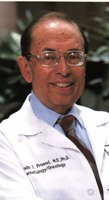
The American Physiological Society will recognize Ananda Prasad, M.D., Ph.D., Wayne State University Distinguished Professor of Internal Medicine, as a medical scientist whose work has significantly advanced the discipline and profession of physiology.
Dr. Prasad, a world-renowned expert in zinc as a mineral essential to human life, will be honored at the APS symposium April 25 in San Diego, Calif. During the symposium, the society will recognize the achievements of 35 of its members during the past 125 years.
"I am very excited that my discovery of human zinc deficiency 50 years ago will be the subject of a symposium. This is a great honor because usually in a history symposium, the works of deceased scientists are presented, but I will be witnessing living history," Dr. Prasad said.
The names and titles of the members' seminal publications will be highlighted during a Federation of American Societies for Experimental Biology symposium at same meeting.
Dr. Prasad has made important strides researching the mineral zinc, as well as contributing significantly to the field of hematology and sickle cell disease. His work with zinc began when one of his former professors received an invitation from the Shah of Iran to establish a medical curriculum at the University of Shiraz Medical School and invited Dr. Prasad to accompany him. Two weeks after his arrival, a 21-year-old man who looked like an 8-year-old boy came to Dr. Prasad. The patient lacked secondary male characteristics, was considered mentally lethargic and ate clay. Dr. Prasad diagnosed the man's condition as extreme anemia, but couldn't understand how such a condition came about because most males do not develop anemia without bleeding.
The condition was so prevalent in Iran that it was considered an epidemic. Dr. Prasad studied the condition and hypothesized that because plants do not grow without sufficient zinc, perhaps people do not either.
In the developed world, zinc abounds in a variety of food sources, such as fresh fish, red meat, oysters and dairy products. In developing countries, diets primarily consist of breads and grains, which contain phytate, a substance that binds zinc and iron and prevents both minerals from being absorbed by the human body.
In 1961, Dr. Prasad published an article in the American Journal of Medicine suggesting for the first time that zinc deficiency could account for human growth retardation. In a subsequent paper based on studies done in similar patients from Egypt, Dr. Prasad established the study subjects suffered zinc deficiency. That study was published in The Journal of Laboratory and Clinical Medicine in 1963 and later was republished in 1990 as a landmark article in the same journal.
After the publication of these papers, Dr. Prasad started administering zinc through clinical trials, and his subjects began growing taller and developing male characteristics.
Since then, Dr. Prasad has continued to study the role zinc plays in human development. In 1975, he suggested the National Research Council set the Recommended Daily Allowance for zinc at 15 milligrams per day.
In addition, his zinc studies have saved countless lives in African and Asian countries, including India, Pakistan and Bangladesh. In these areas, the mortality rate from infantile diarrhea approached 85 percent. When the United Nations Educational, Scientific and Cultural Organization adopted zinc supplements to combat infant diarrhea in these regions, that mortality rate dropped to 15 percent.
In December 2009, TIME magazine named zinc the "miracle mineral."
Dr. Prasad received a congressional commendation for his lifelong studies involving zinc in 2011.